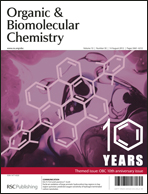Abstract
In order to identify new leads for the treatment of type 2 diabetes, polyenic molecules A and B derived from nipecotic acid and dienol derivatives C have been prepared and their effect on PPARs transcriptional activity evaluated and compared to that of rosiglitazone, WY14,643 and GW501516. Among the synthesized compounds, dienol 39 is the most active, increasing WY14,643 PPARα response and demonstrating partial agonist properties on rosiglitazone PPARγ.

- This article is part of the themed collection: Organic & Biomolecular Chemistry 10th Anniversary

 Please wait while we load your content...
Please wait while we load your content...